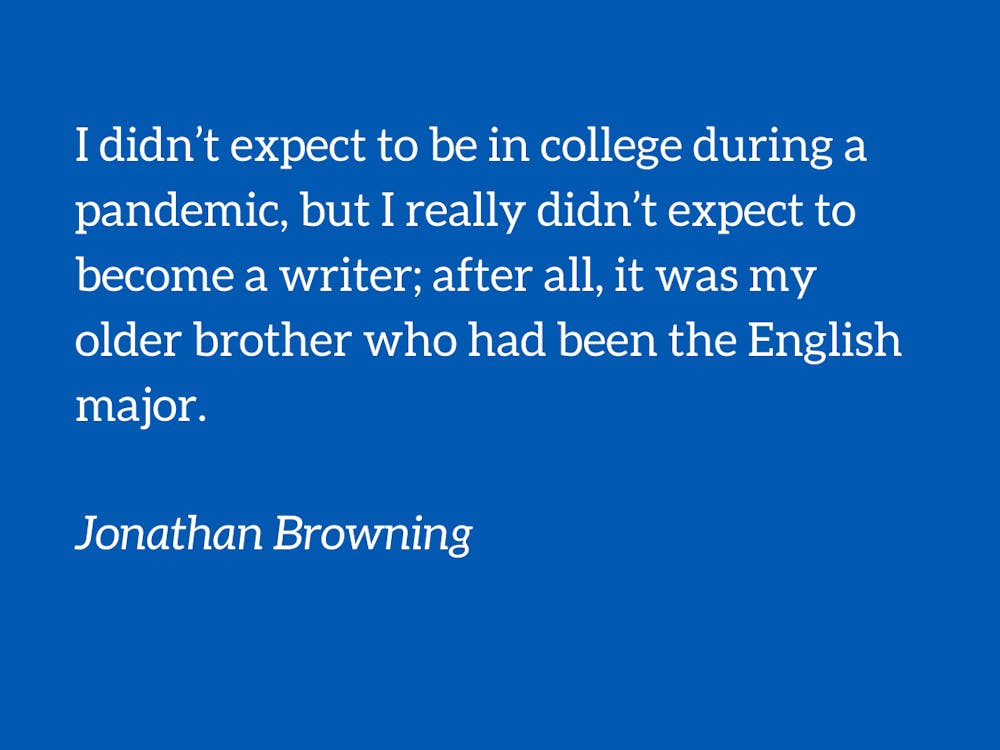College didn’t turn out the way I thought it would.
I know what you’re gonna say—after four years of writing articles, you’re going to begin with a cliche? You’d make a good point, but as I reflect on these last four years, I don’t have a better way of putting it. I came to Duke with a very particular plan: I would join certain clubs, take certain classes, and find my forever friends while in these classes and clubs. And I tried doing these things, only to quickly realize something: my plan sucked—I didn’t like what I was doing. All of a sudden I was back to square zero, and as a naive freshman, I was terrified, convinced my college experience was over before it had really begun.
Luckily, by this time in my freshman fall, I was already on a path that would transform my college career—I just didn’t know it yet.
I don’t remember much about my orientation week; nearly four years out, it’s mostly a blur of moments. However, despite the chaos that marks an undergraduate’s first week at Duke, there is one moment that’s had an outsized influence; in fact, it’s why I’m writing this column.
I don’t remember the date, the building, nor the people that I went with. What I do remember is ending up in one of the athletic buildings, having a dinner that was being provided for the first years. I didn’t know anyone there but, as one does during O-Week, I found some people to talk to. During the course of conversation, attention turned toward what we would do next—during O-Week, there’s always something to do next. Some of the freshmen were going to a soccer game (I think it was a men's game but at this point, I’m not sure) and I decided to join them. That day, I stepped foot in Koskinen Stadium for the first time—it was far from the last.
After that first match, I decided to attend every home soccer game that I could, both men’s and women’s. To this day, I’m not sure why. I was never a huge soccer fan before college and none of my new college friends were either. More often than not, I bused from East to West Campus to watch the games myself. There was just something about Koskinen that kept me coming back.
Once the season ended I realized something: if I was going to go to every soccer game, I should do more than just attend; I should find a way to give back. So I emailed The Chronicle’s sports editor at the time, Michael Model, and asked if I could cover women’s soccer the next fall, despite having never written a sports article before (truthfully, I’m not even sure if I had read The Chronicle before). Michael said I could, if I joined The Chronicle then. So I did. Of all the emails I’ve sent in college, there are few that have had a greater effect than that one.
It took me more than three months to write my first article. I was terrified of having something published -- what if I couldn’t actually write? (I still have this fear, I’ve just gotten better at ignoring it.) A month later, I started to find my rhythm and voice; all it took was a return to Koskinen Stadium to cover women’s lacrosse. Once again, after a slow start to a new venture, Koskinen had saved me. And since then, it’s presented me with opportunity after opportunity.
I watched as women’s soccer won their 400th game in program history. I witnessed Emmy Duerr score her first two career goals in Duke’s opening round NCAA win. I opined on what could’ve been after women’s lacrosse saw their season cut short due to COVID-19. I had to keep myself from cheering in the press box as Sophia LeRose made a game-sealing save in the NCAA tournament. This year, my jaw dropped as a beautiful Caitlin Cosme free kick sealed the Blue Devils first win over Stanford in Durham in more than 30 years. And, most recently, I wrote about history in the making, as Maddie Jenner set the program record for career draw controls.
Sports isn’t just about the box scores and moments. It’s about the people. Koskinen Stadium and The Chronicle have allowed me the opportunity to speak with so many great ones. I talked with women’s soccer legend Carla Overbeck. I got to pick the brains of two women’s soccer players as they reflected on a season unlike any other. Time and time again, I spoke with two of the greatest coaches in their respective sports in Robbie Church and Kerstin Kimel. If either of them are reading this by chance, thanks for answering the questions of a kid who didn’t know anything about soccer or lacrosse—I hope my questions have gotten better over the years. And perhaps most important, I got to talk with my fellow writers, who constantly inspired me.
I didn’t expect to be in college during a pandemic, but I really didn’t expect to become a writer; after all, it was my older brother who had been the English major. I’d always been a slightly nerdy math kid. But I’m beyond glad that I did—so many of my favorite college memories have stemmed from The Chronicle. But without Koskinen, none of those would have happened. And so, as I wrap up my time at The Chronicle, all I have left to say is this: Thank you Koskinen Stadium—college wouldn’t have been the same without you.
Get The Chronicle straight to your inbox
Signup for our weekly newsletter. Cancel at any time.

